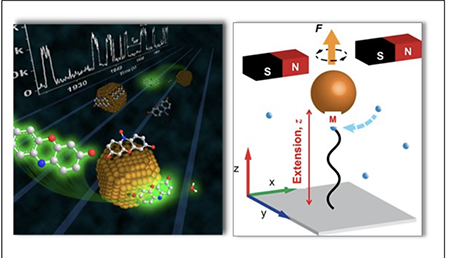
|
Single-molecule imaging approaches have revolutionized the study of chemical and biological systems due to their power of dissecting the real-time behaviors of individual entities. In the past 14 years, my group has pushed the development and application of single-molecule approaches in studying catalysis on single nanoparticles (i.e., heterogeneous catalysis) and catalysis by transition metal complexes in making polymers (i.e., homogeneous catalysis) (Figure 1).
For nanoparticle catalysis, due to the intrinsic heterogeneity among individual particles and surface structural dynamics (the latter is particularly relevant for nanometer sized particles), studying their catalytic behaviors at the single-particle level in real time is crucial for understanding their fundamental catalytic properties. Using single-molecule fluorescence imaging combined with a fluorogenic reaction approach (Figure 1, left), we have imaged catalytic reactions on individual nanoparticles at single-turnover resolution in real time under operando conditions. We have discovered temporal activity fluctuations of individual nanoparticles, attributable to their dynamic surface restructuring, whose timescales, energetics, and dependences on particle size and materials were quantified. We have extended the single-molecule imaging approach to screen the activity of catalyst particles in a massively scalable and parallel way with single-particle, sub-diffraction resolution. Using single-molecule localization microscopy, we spatially resolved and mapped reactions on individual particles at nanometer resolution, directly visualizing site-specific activity and uncovering spatial activity gradients within single facets. We further discovered cooperative communication between reactions on the same catalyst particle, in which reactions occurring at different locations on the same catalyst affect each other positively, phenomenologically similar to enzyme cooperativity but mechanistically distinct. For polymerization catalysis, due to the intrinsic conformational heterogeneity among individual polymer molecules, their growth behavior during polymerization reactions is expected to differ from one to another and from time to time, but it was unknown how they would differ and what the consequences would be. We have developed a magnetic tweezer-based approach (Figure 1, right) to visualize real-time polymer growth at the single-polymer level. Focusing on ring-opening metathesis polymerization catalyzed by a Ru-based transition metal complex, we found that the extension of a growing polymer under a pulling force does not increase continuously but exhibits wait-and-jump steps. These step-wise behaviors are attributable to the formation and unraveling of conformational entanglements from newly incorporated monomers, which only occur under nonequilibrium living polymerization conditions. The configurations of these entanglements appear to play a key role in determining the polymerization rates and the dispersion among individual polymers, raising the possibility to manipulate their configuration to alter polymerization kinetics and dispersion.
|
|||||||||||||||||
